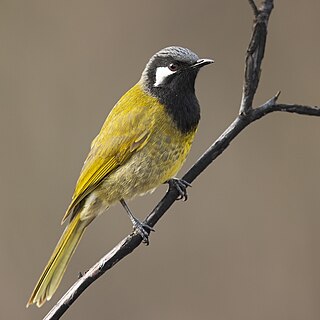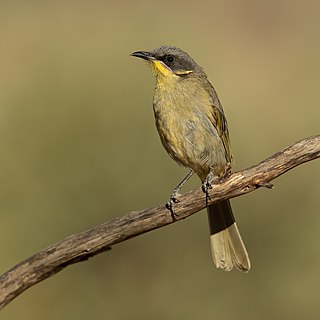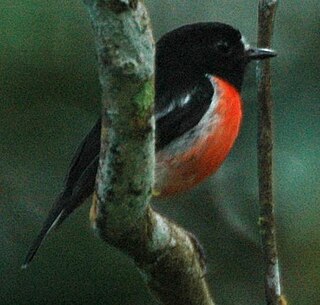
Lewin's honeyeater is a bird that inhabits the ranges along the east coast of Australia. It has a semicircular ear-patch, pale yellow in colour.

The scarlet myzomela or scarlet honeyeater is a small passerine bird of the honeyeater family Meliphagidae native to Australia. It was first described by English ornithologist John Latham in 1801. At 9 to 11 cm long, it is the smallest honeyeater in Australia. It has a short tail and relatively long down-curved bill. It is sexually dimorphic; the male is a striking bright red with black wings, while the female is entirely brown. The species is more vocal than most honeyeaters, and a variety of calls have been recorded, including a bell-like tinkling.

The yellow-faced honeyeater is a small to medium-sized bird in the honeyeater family, Meliphagidae. It takes its common and scientific names from the distinctive yellow stripes on the sides of its head. Its loud, clear call often begins twenty or thirty minutes before dawn. It is widespread across eastern and southeastern Australia, in open sclerophyll forests from coastal dunes to high-altitude subalpine areas, and woodlands along creeks and rivers. Comparatively short-billed for a honeyeater, it is thought to have adapted to a diet of flies, spiders, and beetles, as well as nectar and pollen from the flowers of plants, such as Banksia and Grevillea, and soft fruits. It catches insects in flight as well as gleaning them from the foliage of trees and shrubs.

The white-cheeked honeyeater inhabits the east coast and the south-west corner of Australia. It has a large white patch on its cheek, brown eyes, and a yellow panel on its wing.

The silver-throated tanager is a species of passerine bird in the tanager family Thraupidae. It is found in Costa Rica, Panama, Colombia, Ecuador, and northeastern Peru. It inhabits mossy forests, montane evergreen forests, tropical lowland evergreen forests and forest edges, along with tall secondary forests and disturbed habitat with remnant trees and forest. It is 13 centimetres (5.1 in) long and weighs 22 grams (0.78 oz) on average, and shows slight sexual dimorphism, with duller female plumage. Adult males are mainly bright yellow, with a silvery-white throat bordered above with a black stripe on the cheeks, black streaking on the back, and green edges to the wings and tail. Juveniles are duller and greener.

The white-eared honeyeater is a medium-sized honeyeater found in Australia. It is a member of the family Meliphagidae which has 190 recognised species with about half of them found in Australia. This makes them members of the most diverse family of birds in Australia. White-eared honeyeaters are easily identifiable by their olive-green body, black head and white ear-patch.

The Bonin white-eye or meguro (メグロ) is a small songbird endemic to the Bonin Islands of Japan. It is the only species in the genus Apalopteron. Its taxonomic affinities were a long-standing mystery and it has been placed with the bulbuls, babblers and more recently with the honeyeaters, during which it was known as the Bonin honeyeater. Since 1995 it is known to be a white-eye in the family Zosteropidae, that is closely related to the golden white-eye of the Marianas Islands.

The brown honeyeater is a species of bird in the family Meliphagidae. It belongs to the honeyeaters, a group of birds which have highly developed brush-tipped tongues adapted for nectar feeding. Honeyeaters are found mainly in Australia, New Guinea, and parts of Indonesia, but the brown honeyeater is unique in that it also occurs on the island of Bali, making it the only honeyeater to be found west of the Wallace Line, the biogeographical boundary between the Australian-Papuan and Oriental zoogeographical regions.

The yellow-throated miner is a species of colonial honeyeater, endemic to Australia. It is also known as the white-rumped miner. The distinctive white rump is easy to observe in the field and distinguishes it from the other miner species. Yellow-throated miners are medium-sized, grey passerines with yellow throat markings, legs, and bare patches around the eye. The common name 'miner' is an alternative spelling of the word myna, mynah or minah, and is shared with other members of the genus Manorina. Though miners were originally named due to their resemblance to the common myna of South and Southeast Asia that shares similar yellow eye-patch and legs, common mynas are from the starling family and are not closely related to the honeyeater family. Common mynas are an aggressive introduced pest in Australia, which causes some confusion with the native aggressive miners.

The striped honeyeater is a passerine bird of the honeyeater family, Meliphagidae, found in Australia. It is a medium-sized honeyeater, about 23 cm (9.1 in) in length. Both sexes are a light greyish brown with dark brown centres to the feathers, which give the appearance of stripes. The stripes are particularly distinct on the head and back of the neck. While it is found mainly in inland eastern Australia where it inhabits the drier open forest, it is also found in coastal swamp forest from southeast Queensland to the central coast of New South Wales.

The spiny-cheeked honeyeater is the only species in the genus Acanthagenys. It is large for a honeyeater, ranging from 22 to 27 centimeters tall and weighing around 52 grams. The birds are sociable, aggressive, and often observed foraging in large flocks.

The crescent honeyeater is a passerine bird of the honeyeater family Meliphagidae native to southeastern Australia. A member of the genus Phylidonyris, it is most closely related to the common New Holland honeyeater and the white-cheeked honeyeater. Two subspecies are recognized, with P. p. halmaturinus restricted in range to Kangaroo Island and the Mount Lofty Ranges in South Australia.

The purple-gaped honeyeater is a species of bird in the family Meliphagidae. It is endemic to semi-arid southern Australia, where it inhabits mallee, tall heath and associated low eucalypt woodland.

The mangrove honeyeater is a species of bird in the honeyeater family Meliphagidae. The species was once considered to be conspecific with the varied honeyeater, but it is now treated as a separate species. These two species form a genus with the singing honeyeater.

The yellow-throated honeyeater is a species of passerine bird in the honeyeater family Meliphagidae. It is similar in behaviour and appearance to the white-eared honeyeater and is endemic to Australia's island state of Tasmania. It was formerly considered a pest of orchards.

The silver-eared honeyeater is a species of bird in the family Meliphagidae. It is found in New Guinea. Its natural habitat is subtropical or tropical mangrove forests.

Lichmera is a genus of bird in the honeyeater family Meliphagidae.

The red-headed myzomela or red-headed honeyeater is a passerine bird of the honeyeater family Meliphagidae found in Australia, Indonesia, and Papua New Guinea. It was described by John Gould in 1840. Two subspecies are recognised, with the nominate race M. e. erythrocephala distributed around the tropical coastline of Australia, and M. e. infuscata in New Guinea. Though widely distributed, the species is not abundant within this range. While the IUCN lists the Australian population of M. e. infuscata as being near threatened, as a whole the widespread range means that its conservation is of least concern.

The Pacific robin, is a red-breasted Australasian robin in the passerine bird genus Petroica found in Melanesia and Polynesia. It is similar in plumage to the scarlet robin of Australia, and until recently the two were considered conspecific until split in 1999 by Schodde and Mason. Thirteen subspecies of Pacific robin are currently recognised, and these subspecies display considerable variation in plumage, foraging preferences, and habitat. The Norfolk robin was previously considered a subspecies of the Pacific robin, but is now considered a distinct species.

The New Zealand fantail is a small insectivorous bird, the only species of fantail in New Zealand. It has four subspecies: R. f. fuliginosa in the South Island, R. f. placabilis in the North Island, R. f. penita in the Chatham Islands, and the now-extinct R. f. cervina formerly on Lord Howe Island. It is also known by its Māori names, pīwakawaka, tīwakawaka or piwaiwaka, and the Chatham Island subspecies by the Moriori name tchitake; the common pied morph is also known as pied fantail, and the uncommon dark morph is also known as black fantail. The species has been considered by many to be conspecific as the grey fantail of Australia and New Caledonia; however, due to significant differences in its calls, many authorities now treat it as a separate species.





















